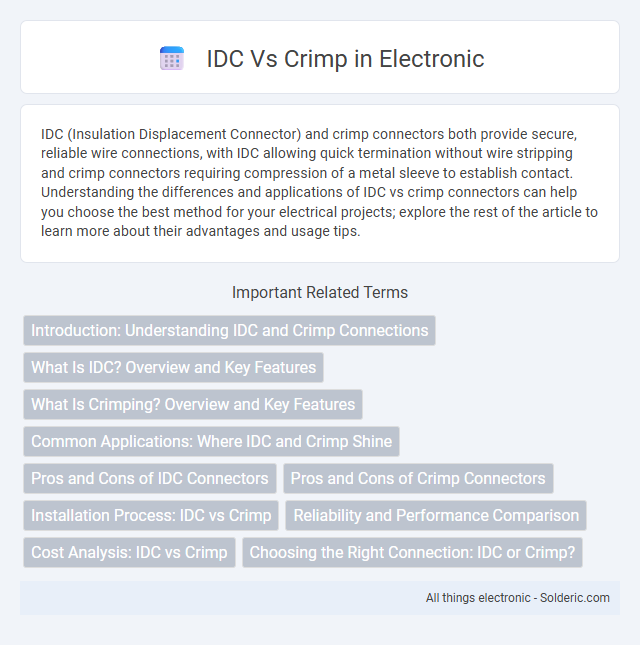IDC (Insulation Displacement Connector) and crimp connectors both provide secure, reliable wire connections, with IDC allowing quick termination without wire stripping and crimp connectors requiring compression of a metal sleeve to establish contact. Understanding the differences and applications of IDC vs crimp connectors can help you choose the best method for your electrical projects; explore the rest of the article to learn more about their advantages and usage tips.
Comparison Table
| Feature | IDC (Insulation Displacement Connector) | Crimp Connector |
|---|---|---|
| Connection Method | Connects by piercing insulation to contact wire directly | Connects by compressing a metal sleeve around the wire |
| Installation Speed | Faster, no stripping required | Slower, requires wire stripping |
| Reliability | Good for quick, mass terminations | Highly reliable with proper tools |
| Tools Required | Special IDC tool or punch down tool | Crimping tool specific to connector type |
| Wire Types Supported | Solid and stranded wires | Generally better for stranded wires |
| Common Applications | Telecommunications, networking (e.g., RJ45, RJ11) | Automotive, aerospace, heavy-duty cables |
| Durability | Moderate; may degrade with repeated reconnection | High; strong mechanical bond with wire |
| Cost | Lower labor cost, connector price moderate | Higher labor cost, connector price varies |
Introduction: Understanding IDC and Crimp Connections
IDC (Insulation Displacement Connector) and crimp connections are essential methods for creating reliable electrical contacts without soldering. IDC allows quick, tool-assisted insertion of insulated wires into connectors by displacing insulation, ensuring consistent contact and reducing installation time. Crimp connections secure wires by deforming metal terminals around stripped conductors, providing strong mechanical bonds and excellent electrical conductivity for high-performance applications.
What Is IDC? Overview and Key Features
Insulation Displacement Connector (IDC) is a type of electrical connector designed to connect wires without the need to strip insulation. It features sharp metal blades that pierce the insulation, establishing a reliable contact with the conductor inside. Your wiring projects benefit from IDC's quick installation, consistent electrical performance, and secure connections ideal for telecommunications and networking applications.
What Is Crimping? Overview and Key Features
Crimping is a mechanical process that joins a connector to a cable by deforming one or both components to hold them together securely. Key features of crimping include the use of specialized tools to apply precise pressure, creating a reliable, low-resistance electrical connection ideal for automation and telecommunications. This method ensures strong mechanical bonds and consistent performance, especially in environments requiring vibration resistance and durability.
Common Applications: Where IDC and Crimp Shine
IDC connectors excel in rapid assembly applications such as telecommunications and networking, where consistent, reliable wire-to-connector contact is essential. Crimp connectors are preferred in automotive, aerospace, and industrial environments requiring strong mechanical bonds capable of withstanding vibration and mechanical stress. Both IDC and Crimp technologies are vital in electronics manufacturing, with IDC suited for mass termination and Crimp for robust, high-reliability connections.
Pros and Cons of IDC Connectors
IDC connectors offer quick and reliable connections by piercing the wire insulation without the need for stripping, making assembly faster and reducing labor costs. Their main drawback is that improper alignment or repeated connections can damage wires, compromising signal integrity and durability. You benefit from simplified installation but must ensure precise handling to avoid potential failures in your electronic projects.
Pros and Cons of Crimp Connectors
Crimp connectors provide a reliable, vibration-resistant electrical connection ideal for automotive and industrial applications, offering strong mechanical retention without the need for soldering. However, improper crimping can lead to weak connections, increased resistance, or potential failure, requiring precise tools and techniques to ensure consistent quality. They are cost-effective and quick to install but less suitable for high-frequency signals or environments requiring frequent disconnection compared to IDC connectors.
Installation Process: IDC vs Crimp
The installation process of IDC (Insulation Displacement Connector) involves simply inserting a pre-stripped wire into the connector slot, where metal blades pierce the insulation to create a secure electrical contact without soldering. Crimp connectors require the wire to be stripped and then compressed firmly with a crimping tool to deform the metal sleeve around the conductor, ensuring mechanical stability and conductivity. IDC connectors offer faster and more consistent installations suitable for mass wiring, while crimping requires more precision and is preferred for applications demanding higher mechanical strength.
Reliability and Performance Comparison
IDC (Insulation Displacement Connector) offers reliable and consistent electrical connections by piercing insulation without stripping wires, reducing installation errors and improving durability in high-vibration environments. Crimp connectors provide strong mechanical bonds through compression, ensuring excellent conductivity and long-term stability, especially in high-current applications. Your choice depends on performance needs: IDC suits quick assembly with moderate current, while crimp ensures maximum reliability and performance with robust, durable connections.
Cost Analysis: IDC vs Crimp
IDC connectors typically offer lower labor costs due to faster installation times and reduced need for specialized tools, making them cost-efficient for high-volume production. Crimp connectors, while often more expensive in terms of initial tool investment, provide superior mechanical strength and reliability that can reduce long-term maintenance costs. Your choice depends on balancing upfront expenses against durability requirements and operational priorities.
Choosing the Right Connection: IDC or Crimp?
IDC (Insulation Displacement Connector) offers quick, reliable connections without stripping wires, ideal for high-volume or rapid assembly tasks. Crimp connectors provide a stronger mechanical and electrical bond through compression, making them suitable for applications requiring durability and long-term stability. Selecting between IDC and crimp depends on balancing installation speed, reliability, and environmental factors within the specific use case.
IDC vs Crimp Infographic

 solderic.com
solderic.com